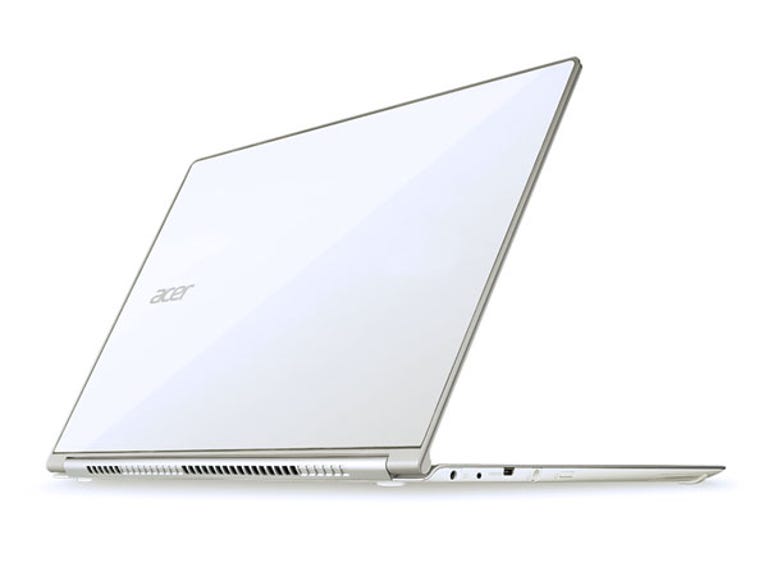 Why You Can Trust CNET
Why You Can Trust CNET Acer Aspire S7 (13.3-inch) review: Acer Aspire S7 (13.3 inch)
The 13.3-inch version of Acer's Aspire S7 laptop is gorgeous. There are a few minor niggles, it's expensive and battery life isn't the best, but despite all this, this is one of the better Windows 8 solutions out there at this point in time.
The 13.3-inch version of Acer's Aspire S7 is rather striking. With a white lid covered in Gorilla Glass, a white base, screen bezel and silver interior, this is one of the nicer-looking Windows 8 laptops.
The Good
The Bad
The Bottom Line
Connectivity
- Touchscreen: yes
- USB 3.0: 2
- Video: micro HDMI (VGA via adapter)
- Ethernet: 100Mbps via USB 2.0 adapter
- Wireless: dual-band 802.11n, Bluetooth 4.0
The lid is a bit difficult to open, but once you're there, you're treated to a gorgeous 1080p IPS screen (which increases resistance the further you open it, so the screen doesn't wobble when you tap it), a backlit keyboard and a large touch pad. Our review touch pad was a little loose and clacky, but we did receive a pre-production version of the S7, so hopefully this is fixed for the final release. Speakers are best described as functional — you'll get much better results out of having a set of headphones plugged in.
Much like the 11.6-inch version, the backlit keyboard actually makes things more difficult to see in half-light, appearing in a somewhat dull aqua. In the dark, though, it's perfectly fine. The travel is quite short on all of the keys, due to the thinness of the laptop, so if you're put off by shallow typing, it's best to look elsewhere.
Like the 11.6-inch model, Acer has also made some interesting keyboard shuffles. You'll find a giant delete key to the left of the arrow keys, for a start. The Caps Lock key is tiny, as to the right of it a tilde has been crammed in. The dedicated home/page up and end/page down buttons that have been placed around the arrow keys are also a bit of a mind bend, considering that these are usually on the arrow keys themselves, and activated by the Fn key. One thing does make sense, though: Acer has moved the F1-F12 keys down to the number buttons, and activated by the Fn key.
The Australian version of the S7 comes with a Core i7 3517U, 4GB of RAM and two LiteOn 64GB SSDs in RAID 0, to make up a 128GB drive. Interestingly, this is lower specced than the 11.6-inch version, which comes with dual 128GB SSDs to form a single 256GB module. While you'd expect the difference in capacity to ratchet up the price, bizarrely the 13.3-inch model costs AU$1999, while the 11.6-inch model costs AU$1799.
Two USB 3.0 ports, an SD card reader, headset jack and micro-HDMI port make up the connectivity contingent, along with dual-band 802.11n Wi-Fi and Bluetooth 4.0. Acer includes a USB to 100Mbps Ethernet adapter, a micro HDMI to VGA adapter and Bluetooth mouse in its package, as well as a faux-leather pouch to protect your laptop.
Application performance
Choose a benchmark: Handbrake | iTunes | Photoshop | Multimedia
While for the most part it's quiet, just like the 11.6-inch model the S7 can whip up quite a noise under load.
Battery life
We've moved to a new battery test for Windows 8, a modified version of our heavy battery test for Windows 7. We loop a 720p video until battery depletion, with the screen brightness set to 40 per cent and the ambient brightness adjustment turned off.
Out of the Windows 8 laptops we've tested so far, the 13.3-inch version of the S7 does reasonably well. In the context of the more frugal Windows 7 laptops, things don't look so healthy. We'd imagine that it's a combination of a limited battery space and the full HD IPS touchscreen that's putting most of the strain on the laptop.
Conclusion
The 13.3-inch version of Acer's Aspire S7 laptop is gorgeous. There are a few minor niggles, it's expensive and battery life isn't the best, but despite all this, this is one of the better Windows 8 solutions out there at this point in time. Let's hope Acer finds a way to bring the cost down.


